Bathroom decoration: stylish and unusual design ideas
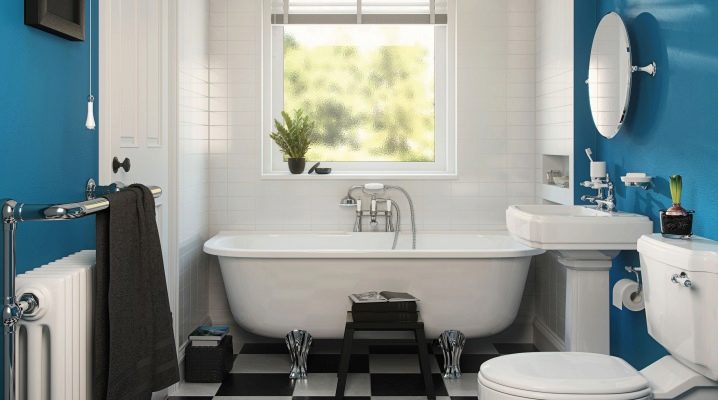
Regarding bathroom renovation, a number of questions arise. Even an ordinary buyer knows that this raw material must meet certain parameters. To exclude an abstract understanding of the issue, to approach the purchase consciously, you need to study in detail the features of different materials, considering the approach to finishing from different angles.

Peculiarities
The bathroom is a special place in any home. It is in it that a high level of humidity, a constant temperature drop, and condensation are noted. Here, any kind of material is constantly tested for fixing strength, durability, abrasion resistance under the influence of household chemicals. The extreme conditions of this room cut off a lot of different finishing materials, which often confuses the buyer.






It is customary to understand the bathroom finish as a list of materials for wall, floor and ceiling cladding. These are coatings of different composition, size and density. They are different in production method, thickness, assembly process and appearance. Regardless of the type of raw material used, a list of basic requirements has been developed for it. Their accounting is the main selection criteria when buying in a store or online.




Requirements for finishing materials for the bathroom
| Durability | This coating does not provide for frequent adjustments or dismantling. |
| Strength | The lined surface should not suffer from accidental mechanical shock, vibration of the washing machine, prolonged exposure to water. |
| Antistatic | The properties of the material should exclude the appearance of an environment for the formation and reproduction of fungi and mold. |
| Environmental friendliness | The finishing material used should not harm the health of households and allergy sufferers. |
| Ease of care | Any contamination should not fit into the surface and become part of the pattern. |
| Abrasion resistant | The coating must be resistant to aggressive chemicals with regular cleaning. |
| Fire safety | In the event of a short circuit, the lining will not catch fire, regardless of the cause. |
| Aesthetics | The coating should be attractive in appearance. |






The material used for finishing should not allow water to pass to the foundations of the floors and enclosing structures. For this reason, the same requirements apply to additional materials that can serve as the basis for cladding. These are niches and partitions made of drywall, albeit moisture resistant. The use of such structures in the bathroom is undesirable.


The type of material determines the technology of its use. If this is a free-flowing option, it is smeared on the walls after dilution. In another case, they are attached to glue, cover the plane with it, and stretch it onto the frame. For each method, they use their own compositions, workflow technologies, a set of tools. The time of the veneer, its drying and final processing also differs.


Failure to comply with the rules of facing is the reason for a reduction in service life, deformation during operation. The aesthetic side of the issue also suffers. Some materials require special fixatives while the glue dries. Their purchase and use will allow you to perform installation at a professional level, observing the identity of the gaps between the fragments.
Advantages and disadvantages
Bathroom finishing materials have a number of advantages.In the modern construction market, they are presented in a wide range. The choice is striking in its variety and meets all the needs of the buyer, satisfying even the most demanding customers. Trademarks are constantly improving manufacturing technologies, which contributes to improving the quality and performance of the material.




With the help of finishing materials, you can hide unsightly surfaces, change the aesthetic perception of the bathroom space. This often allows you to mask irregularities, potholes and chips in the surfaces of wall, floor and ceiling ceilings. In some cases, the use of finishing materials evens out the height difference and length of the walls. Certain types are attached to the frame and even to suspensions.

Various modern raw materials are used in the decoration of the bathroom. Most of it is capable of imitating the desired texture. Due to this, the buyer can decorate the bathroom interior in any design style without prejudice to the main idea. The choice allows you to demonstrate classic, modern, ecological, vintage, creative stylistics directions. If desired, you can show the texture of wood, marble, gold, stucco.






In the list of finishing materials for the bathroom, manufacturers include products for different strata of the population. This allows the average buyer to do their own budget repairs. Due to the availability of specialized means for fixing the cladding in stores, as well as sometimes simple instructions for the workflow, you do not need to resort to the help of a specialist. Self-repairing significantly saves the budget and is often better in quality, because the owner is interested in an excellent result.

The uniqueness of different finishing materials lies in the fact that they are combined with each other. The combination allows you to achieve the desired effect, highlight one of the functional areas of the bathroom, which is especially appropriate for a combined bathroom. You can use one type of decoration as a decor, using the technique of panels, paintings. However, the approach to this process must be deliberate. Otherwise, you can overload the bathroom interior.

Finishing materials also have disadvantages. For example, almost every type of material used requires the preparation of the base before fixing. It takes time, you have to spend money on dowels and reinforcements that make the structure of the floors homogeneous. Without preliminary preparation, it is difficult to count on the durability of the cladding.
Some materials make the bathroom look cold. This is especially noticeable on the floor covering, on which you often do not want to step on with bare feet. The problem has to be solved with a warm floor system. It is not suitable for every cladding material. We have to more carefully approach the issue of choosing not only the floor finish, but also the method of floor insulation.

Sometimes foundations are a problem for the use of finishing materials. For example, porous wall ceilings with structural disruptions are not able to hold heavy material. If they crumble before the start of the repair, even when reinforced with a primer, they will not improve the structure for many years. In this case, you have to decorate the walls with inexpensive material, because after some time it will have to be replaced.




The integration of lights and switches for tiles is more difficult than for wall panels. If you need to make a hole for wiring systems, for a mixer, a tap, you have to use a grinder, which can ruin the finishing material. In addition, the finish is never taken back to back, which implies the presence of remnants after the repair. If not stocked, the trim may not be sufficient when trimming or making holes. It is not always possible to buy the missing raw materials: it may not be on sale.

Sometimes the use of the desired material is not possible.For example, in the case of permanent condensation of the ceiling due to leaks from the apartment on top. Here paint and tiles have to be replaced with panels on the frame. There is no other way: the glue will not hold the facing material, you will have to glue it to the ceiling every time.
Material selection
All finishing materials for the bathroom can be conditionally divided according to the type of application: for the floor, ceiling, walls.
Regardless of its type, it can be used as:
- solid canvas;
- separate accent;
- combined reception.






A modern approach to bathroom design involves combining materials with each other, as well as combining them with furnishing elements. Ceilings and floors form the basis for the interior, therefore it is important that they are combined with each other, with furniture and plumbing. If there is already furniture, a washing machine, a bathroom, a sink, the materials are selected in such a way as to exclude the merging of parts with the walls and floor. The emphasis is on color and texture, creating the illusion of an ensemble.




On the floor
For the bathroom floor, you can use tiles, porcelain stoneware, epoxy floors, mosaics. The best choice is considered to be a stone. Today, this finish is the focus of design for two reasons: it is stylish and durable. Artificial stone is produced with such high quality that at first glance it is difficult to distinguish it from natural. The marble finish looks beautiful.




They try to pick up the texture of the flooring with anti-slip. This is a slight relief or roughness, a matte surface with a protective film. Porcelain stoneware is convenient for large slabs. The disadvantage is their weight, but the thickness is enough to withstand significant mechanical stress and weight loads. Such a coating is also resistant to constant vibrations of the washing machine if it is planned to be installed in the bathroom.

The advantage is the ability to create a reliable coating that does not need to be adjusted for many years. Floor ceramics are an alternative to porcelain stoneware, they are thinner and smaller in size. However, it will be no less appropriate for floor decoration. Its advantage is the ability to lay out different patterns up to carpet imitations with the addition of borders. This allows you to play up the practicality of the floor in the most walkable areas of the bathroom.

Mosaic is a complex floor decoration technique. She is beautiful, unique, but labor intensive and not always appropriate. It is problematic to do it professionally without some experience. However, when buying material on the net it is possible. Such a variety is identical fragments, predominantly square or rectangular, glued to a special grid, laid out in a certain pattern.

Epoxy flooring offers a ton of design possibilities. It allows you to convey the desired atmosphere using the technique of drawing in 3D. The theme can be different, while the pattern sets the tone for the entire bathroom interior. However, when using a volumetric image, you have to limit the decoration of the walls and ceiling. The use of laminate and linoleum for the bathroom floor is undesirable. Even with a high class of coatings designed for industrial facilities, they will not be durable in the bathroom.

For walls
You can decorate the walls in the bathroom with tiles, mosaics, siding, self-adhesive film. Everyone chooses a finishing material option based on their own capabilities and budget. For some, it is enough to finish the walls with waterproof paint, while others choose coatings in the form of tiles or wall panels.




The use of self-adhesive PVC film is appropriate for small sections of walls. It is possible to arrange cheaply with its help a niche located at a certain distance from the bathroom and sink area. It is not suitable where you have to constantly rub the surface, removing limescale. It is undesirable to use wallpaper, even if it is moisture resistant and washable.The protective layer of such coatings is not designed for constant exposure to moisture and abrasives.

The best option for decorating the walls of the bathroom is their tiling. At the same time, a composite technique with the addition of a small accent on the background is in vogue. However, modern wall companion tiles are different from their counterparts of the past. If earlier accent fragments were inserted mainly in a checkerboard pattern or in the form of a border, today the accent is an image on several tiles. Sometimes the picture is made up of dies of different shapes and can occupy the wall behind the bathroom. Together with a monochromatic companion, this finish will create a special atmosphere in the interior.



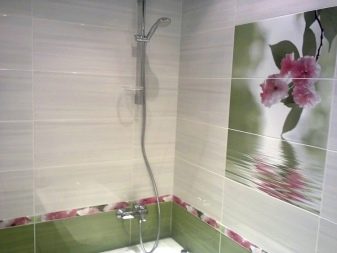
The masters do not recommend using drywall. If it was selected earlier, already installed and planned as a basis for wall ceilings, there is nowhere to go. This option is appropriate in spacious and combined bathrooms, where the air circulation is greater and the ventilation system is thought out. Due to its lightness, heavy material is not suitable for decoration. You can paint the surface.
In the bathroom, mosaics look good on the walls. However, due to the abundance of small fragments, you need to carefully consider their colors and patterns. Moreover, its gluing and location will be complicated by preliminary laying out the pattern on the floor, and then its sequential transfer to the wall. The way out of this situation is to use tiles for mosaics (fragments with a mosaic pattern). It is better to paste over a small part of the walls with mosaics, for example, separating one of the functional areas.

It is better to sheathe the walls not with laminate, but with plastic panels. However, there is also a nuance here. You need to select high-quality varieties. Cheap fakes do not differ in the durability of the pattern. It is erased with constant cleaning, even without the use of household chemicals. For decoration, it is better to take seamless varieties with lock joints. Their seams are thinner, it will be easier to remove dirt from such a finish.

Cement plaster is also worth noting. Of course, options with an admixture of gypsum and lime are not suitable in the bathroom, but a textured mixture with sand is appropriate in some cases. Such decor is especially successful if the bathroom is spacious, and the accent is located far from the bowl and sink. Other types of plaster type in the bathroom cannot be used due to abrasion and flaking.
To the ceiling
The materials for the ceiling are controversial. This is due to the rise of steam up and settling on the surface of the finishing coating. Naturally, whitewash and plaster are inappropriate here. Delaminated coatings, such as laminate flooring, the back of which can delaminate and swell under constant exposure to moisture, will not work either. The use of foam tiles is undesirable.

An interesting solution for decorating the ceiling will be the use of rack structures. In fact, these are plastic panels of a narrow width. They perfectly reproduce any texture, including painted wood, marble, they can have a glossy and matte surface type. The advantage of this coating is resistance to water and ease of maintenance. The disadvantage is the need for careful selection of fixtures.




An unusual solution is plastic, metallized and mirror ceiling tiles. With their help, you can visually change the perception of the bathroom by enlarging the walls and raising the height of the ceiling. The varieties with the 3D effect are especially unusual. The color range of such a finishing material is extensive; it can be matched to the overall concept of the chosen design. Sometimes brands offer to cover the ceiling with a stretch film. This is a PVC-based material with fairly high quality and performance characteristics. However, it can be used mainly in spacious rooms and with high ceilings. In general, this option is possible, it will require the construction of a crate, which will hide the ceiling height by 8-10 cm.

If you need a budget repair, you can paint the ceiling, pre-leveling and sanding it. Paints and varnishes for the ceiling or walls of the bathroom are selected on an acrylic or polyester base. Distribute the composition over the surface using a roller or spray gun. However, such a finishing material cannot be called durable and beautiful, even if you decorate the surface with an unusual pattern.

How to choose color and style?
Bathroom colors depend on several factors. These include:
- footage of a particular room;
- its layout, design features;
- taste preferences;
- the type of material used;
- the effect of color on perception.

Since the bathroom often lacks natural light, this lack is made up for by light shades of the color palette. This is especially important for the bathrooms of old apartment buildings such as "Khrushchev", "Brezhnevka" and "Stalinka". In a modern private, frame or country house, the bathroom may have windows. However, even here it is necessary to use light colors of finishing materials in the design. A beam or brick is a fairly dark base, they hide the light of any room.



The atmosphere in the bathroom should be light. Otherwise, it will be uncomfortable to be in it. The dark tones of the cladding as dominant are excluded. For the ceiling, it is better to choose white or ivory; a milky tone is also suitable. White softens any contrast, which makes it a favorite in design. It can be used in any direction of design. It is harmonious in combination with gilding, silver, bronze, goes well with neutral, natural, pastel shades.

The combination with the bright colors of the palette should be deliberate. Bright, emotionally strong colors of finishing materials can overload the bathroom interior. This will visually make her atmosphere heavy. Red, wine, blue are difficult to perceive. Black at home is undesirable: to give expressiveness to light contrasts, it is better to choose a dark gray or brown shade.

Today, the focus is on the combination of several shades in the decoration of the walls, floor and ceiling. For the integrity of the picture, it is preferable to choose related shades of the same color. However, it will also be useful to dilute it with a muted saturated color.
The following colors can be combined:
- white + marble (white with gray) + silver;
- white + light gray + turquoise;
- brown + white + gold;
- muted olive + white;




- beige + brown;
- white + mint + beige;
- shade of light oak wenge + white;
- blue + gray + white.

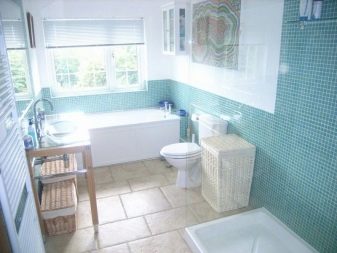


The list of examples is endless. The main thing is that the tones are combined with each other and do not draw attention. This can be achieved in a variety of ways. For example, you can combine the type of texture of finishing materials. For the floor and walls, it is worth using a matte coating; it is better to make the ceiling semi-gloss, with a low reflectivity.

Coating patterns can be used. In order not to overload the bathroom interior, it is worth trying to focus on a simple pattern. It can be a marbled texture, mother-of-pearl lace, aged wood, granite, stone. Simplicity and naturalness are in fashion. It is undesirable to sculpt colorful images. Due to the mass of small details in the bathroom, this can create a sense of clutter.
Stylistics
The choice of style is an individual matter. It is determined by the temperament of the owners of the house, their inner perception. However, in search of the right solution, you often have to limit yourself to the needs and age of all household members. For this reason, traditional design techniques and directions are more often chosen. Of course, the classic style is not suitable for everyone, but many people like modern interior branches (minimalism, bionics, modern, art deco, bauhaus). This is where functionality is best expressed.

However, there are also differences.If the direction of minimalism does not tolerate embellishment, modernity cannot be without elegance. Embedding lighting, the use of modern finishing materials with a synthetic base is what you need, these are the business cards of modern style.
The bohemian style with its peculiar approach to bathroom decoration is not clear to everyone. However, it is unique: the walls can have an imitation of brickwork, rough painting or a concrete base, imitations of beams sometimes protrude demonstratively on the ceiling. With all this, the real communication system is reliably hidden and insulated. Cladding materials provide for the embedding of unusual lighting fixtures (street lamps, fans). Porcelain stoneware is an excellent solution for massive bathtubs and sinks with stone countertops.
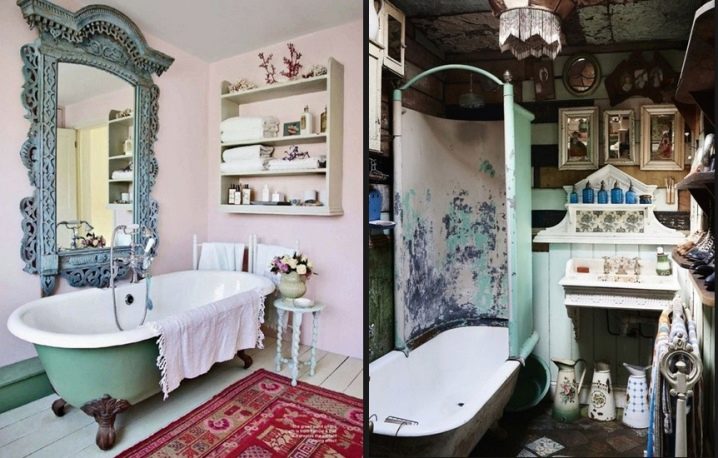
Ethnic trends in bathroom design are also interesting. These include Chinese, Italian, Arabic, African, Japanese, Greek style. Their distinguishing feature is the fact that every detail used in the cladding has a special meaning. This is the texture, shade, size, pattern, compatibility with a specific element of the bathroom furnishings. Sometimes this is an additional decor or even a separate element, for example, imitation of stucco molding on a wall or ceiling, tile relief, baguette.

Destinations such as boho, country and Provence are distinctive. The emphasis is not on accessories, so the decoration of the ceiling, walls and floor should not attract attention. In the first two cases, this is variegation when softened with a light color, you need a light ceiling and plain walls. The Provence style bathroom interior needs a white ceiling with a matte texture and light wall covering. For the floor, it is better to choose something with an imitation of a board or wood texture.

Kitsch, avant-garde and fusion for the bathroom are undesirable. In the first case, abstraction and an abundance of bright colors on the walls, ceiling and floor can disrupt the aesthetic perception and organization. Kitsch will create a sense of chaos as opposed to order. Fusion is a fan of textiles, carpets, curtains and complex combinations that are difficult to convey in a bathroom through the decoration of the walls, floor and ceiling.
Helpful hints
Choosing finishing materials for bathroom decoration, it is worth considering the opinions of professional craftsmen and interior designers, namely:
- the shade of the floor and ceiling cladding must not be identical. Visually, this will reduce the height of the walls;
- the size of the wall or floor decoration must be correlated with the footage of a particular room. The more spacious the room, the larger the size of the fragment;
- two strong colors (red and blue) cannot be combined. They will compete with each other, creating emotional stress in the bathroom;
- in the presence of white plumbing and a bath, the white color of the walls is undesirable. Furniture should stand out against the general background;
- Bathroom linoleum is not an option. Water, getting under the plinth, will be between the base and the back of the coating;
- the abundance of tiles can be softened with wide panels, for example, in the form of a single sheet panel.

To achieve harmony, you need to be able to find a balance between color, images, shape and the amount of materials used. If the accent is highlighted with patterned tiles, the rest of the surfaces should be monochromatic. In this case, the use of soft contrasting combinations is allowed. Bright shades are softened by the white tone of the ceiling, the light background of the walls, muted tones are preferred.

It is undesirable for the color of the finish to match the tone of the doorway. Bright strokes can be used in the drawing, texture, floor color, or leave it to furniture, which should stand out against the general background. This can be a panel, niche decoration, ledge, accentuation of shelves, walls behind a bath or shower, jacuzzi, ceiling decoration.
Wall tiles are thinner than floor tiles. The difference is fundamental: the weight load on the carriers depends on it. The work is carried out separately, according to generally accepted rules.Surfaces are finished based on the characteristics of each type of material for interior decoration. Sometimes it is better to sheathe the walls and ceiling. If the house is just built, it will sit down, which will be reflected in every overlap of the dwelling.

Best options
Beautiful modern photo gallery design ideas will help you get to know more interesting and stylish ideas. A bathroom with masonry looks unusual. Beams, recessed lights, mirrors and expensive furniture create interior comfort.

An example in the Greek style with emphasis on the accent areas of the bathroom. A variety of patterns, a combination of matte and glossy types of surfaces.

An original solution using mosaics and tiles in a confined space. The niche allows you to accommodate the necessary accessories.


An interesting technique for using wall decoration. The decoration is repeated in the design of the corner bath.

Beating the niches of the combined bathroom with tiles of different shades. The combination of white with soft blue brings freshness to the interior.

Compositional approach to bathroom design. Using companion tiles for walls and floors.


A creative approach to loft-style washbasin finishes. Use of wood-effect wall panels.
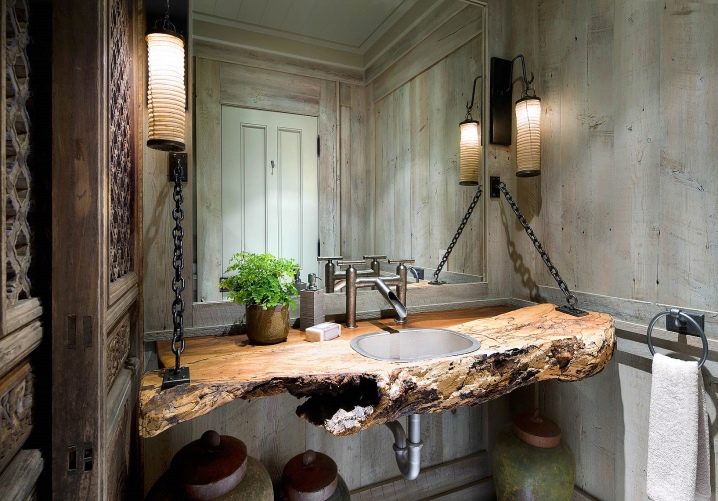
A beautiful Chinese-style bathroom looks unusual. The ceiling is decorated with a floating structure with built-in lighting.

Another custom solution for the bathroom. Floor and wall decoration with tiles. Matte textures with a pattern look unusual together. The effect is enhanced by the shape of the bath.

Siding for interior decoration of bathroom walls will appeal to fans of rich colors. Imitation of brick panels.


Unusual design with slatted panels with aged wood imitation. An interesting combination of material texture for walls, floors and ceilings.


An overview of modern bathroom design awaits you in the next video.













The comment was sent successfully.